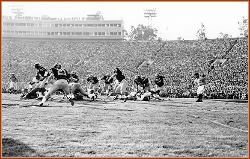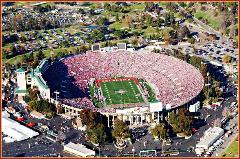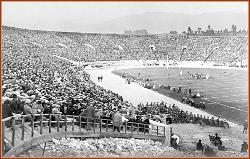





Sanford Stadium is the on-campus playing venue for football at the University of Georgia
in Athens, Georgia. The 92,746-seat stadium is the fifth largest on-campus stadium in the
NCAA. Architecturally, the stadium is known for the fact that its numerous expansions
over the years have been carefully planned to fit with the existing "look" of the stadium.
Games played there are said to be played "Between the Hedges" due to the privet
hedges, which have stood around the field since its opening day in 1929.
History
An early major force behind UGA athletics, the stadium's namesake, Dr. Steadman
Vincent Sanford, arrived at the university as an English instructor in 1903. He later
became the faculty representative to the athletics committee and would eventually
become president of the University and Chancellor of the entire University System of
Georgia. In 1911, he moved the university's football venue from its first location, Herty
Field, to a location at the center of campus which was named Sanford Field in his honor.
In those early years of football, Georgia played a series of controversial games against
in-state rival Georgia Tech. Tech's Grant Field in Atlanta held thousands of spectators,
and Georgia was forced to play those match-ups almost exclusively at Tech's stadium.
Sanford wanted Georgia to have a venue that would equal Tech's, and the "final straw"
came in 1927 when UGA's undefeated (9-0) team traveled to Tech and lost 12-0. It was
alleged that Tech watered the field all night to slow UGA's running backs. Afterwards,
Sanford vowed to "build a stadium bigger than Tech," and play the game at Athens every
other year.
To fund his vision, Sanford had an idea that members of the athletic association would
sign notes guaranteeing a bank loan to fund the stadium construction. Those guarantors
would be granted lifetime seats. The response was overwhelming, and in 1928 a loan of
$150,000 supported by fans and alumni allowed construction to begin on a stadium
whose total cost was $360,000.
Near the existing Sanford Field was a low area between the Old Campus (to the north)
and the Ag Campus (to the south) with a small creek (Tanyard Creek) running through it,
creating a clearly preferable choice for the locaiton of the new stadium. This natural
valley containing Tanyard Creek would result in reduced costs, as stands could be built
on the rising sides of the hill, while the creek could be enclosed in a concrete culvert, on
top of which the field would be constructed. The architect for the stadium was TC Atwood
of Chapel Hill, North Carolina, where North Carolina's Kenan Stadium had just been
completed with a similar design. The 30,000 seat stadium was built in large part with
convict labor, as were many public works projects of that era.
The stadium was completed on time, and UGA convinced perennial powerhouse Yale,
with whom the University had historically maintained close ties, to be their first opponent
in the new stadium. (This also was Yale's first ever football game played in the South.)
On October 12, 1929, a capacity crowd of 30,000+ paid $3.00 per ticket to watch the
Georgia Bulldogs, under coach Harry Mehre, beat Yale 15-0 in Sanford Stadium's
dedication game. Yale donated its half of the game receipts to UGA to help pay off the
construction loans, which would subsequently be completely repaid in just five years. Dr.
Sanford also was at this game, and attended many Georgia games at the stadium named
in his honor until his death on September 15, 1945.
Between the Hedges
Sanford Stadium's famous hedges have encircled the field since the stadium's very first game against Yale in 1929. The idea to put hedges
around the field came from the Business Manager of the UGA Athletic Department, Charlie Morton. Morton claimed to have received inspiration
for the idea during a visit to the Rose Bowl, where he saw the hedge of roses in that stadium. Roses were not a suitable choice for the climate in
Athens, so privet hedges were used instead.
There is a disagreement as to the exact type of hedge planted at Sanford Stadium. The UGA Media Guide claims that the hedge is an "English
privet hedge." A county extension agent in Athens, however, claims online that the hedge is composed of Chinese privet, Ligustrum sinense.
In addition to being a cosmetic touch, the hedges have proven to be an effective (though perhaps unintended) measure of crowd control, as well.
Even though a major traffic path to exit the stadium from both stands runs directly alongside the hedges, fans have only stormed the field and
torn down the goal-posts once in the entire history of Sanford Stadium.
Stadium Expansions
In 1940, field-level lights were added, and Georgia played its first night game against Kentucky to a 7-7 tie. Six thousand seats were also added
to the south side of the stadium in 1949, bringing total capacity to 36,000
During the 1960s, many universities in the South were significantly expanding their stadiums, and Georgia was no different. Soon after the arrival
of head coach Vince Dooley in 1964, UGA began updating Sanford Stadium, removing the field-level lighting (which obstructed views from the
stands) and adding 7,621 temporary end-zone seats, which brought total capacity to 43,621. Architects Heery and Heery of Atlanta were then
hired to plan a major expansion. This expansion planning was very tricky, since by that time the stadium was closely enclosed on both north and
south sides by academic buildings. The plans went forward, however, and an "upper deck" of seats was added to each side of the stadium in
1967 without the need to demolish or alter any of the surrounding buildings. In addition to the new upper decks, this first major addition included
a new pressbox and club seating. In total, 19,640 seats were added to the stadium (bringing total capacity to 59,000), at a cost of $3,000,000.
The new addition was christened with a victory over Mississippi State in 1967.
In 1981, the east endzone stands were enclosed for a cost of $11.5 million, creating a "horshoe-shaped" stadium and eliminating the free view
enjoyed by the "Track People". This addition added 19,000 seats, bringing total stadium capacity to 82,122. The first game in the
newly-expanded stadium was on September 5, 1981, against Tennessee, with Georgia delivering a 44-0 drubbing.
Lights were re-installed in the stadium in 1982. This time, the lights were not located at field level, but attached to the top of the upper level, thus
not obscuring fans' views of the field. The first game under the "new lights" was a 13-7 victory against Clemson on September 6, 1982.
In 1991, a portion of the west endzone stands was enclosed, creating a "partial bowl" around the lower level of Sanford Stadium. The west stands
could not be completely enclosed due to the proximity of Gillis Bridge (usually called "Sanford Bridge"), a major campus transportation artery, to
the stadium. This expansion cost $3.7 million and added 4,205 new seats, bringing total capacity to 85,434.
Thirty luxury suites were added above the south stands in 1994, and were expanded to 50 suites in 2000. These expansions cost a total of $18
million, and raised total capacity to 86,520.
The most recent major addition to Sanford Stadium was in 2003, when another upper deck was added to the north side of the stadium. This
added 5,500 new seats to the stadium at a cost of $25 million, bringing total stadium capacity to 92,058. Currently, most of these "upper-upper
deck" seats are reserved for the fans of the visiting team.
The stadium reached its current capacity of 92,746 in 2004, when 27 SkySuites were added to the North side of the stadium at a cost of $8
million.






